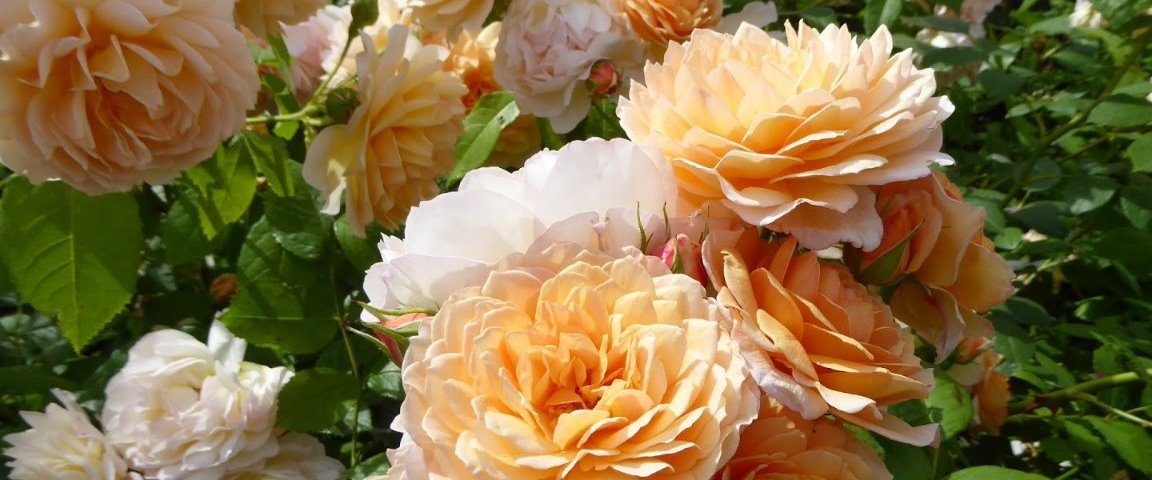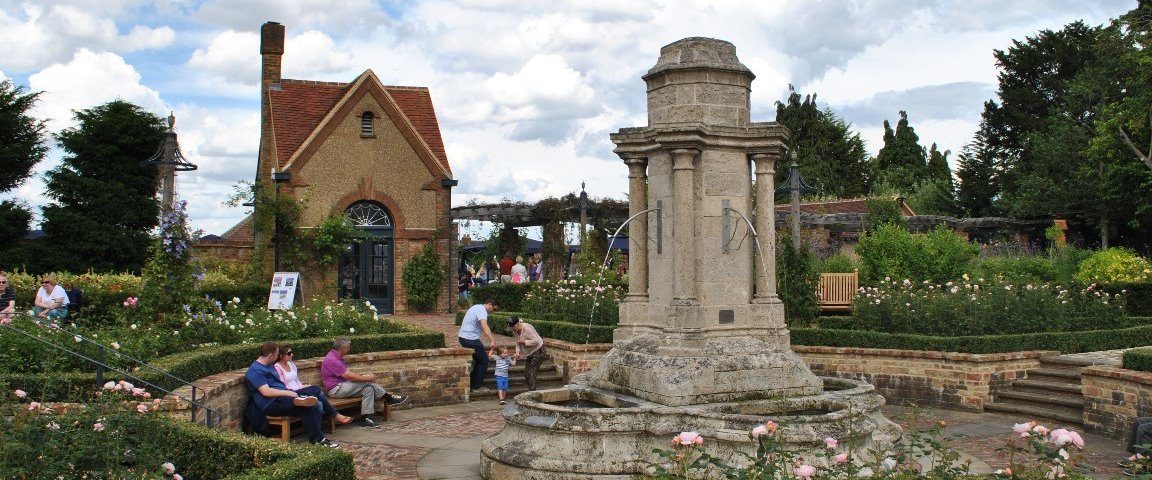Bushey Rose Garden
7.30am-4pm winter, 7.30am to 7pm summer
0.5 ha Grade II registered Park and Garden of Special Historic Interest in Bushey. 2 routes and 16 points of interest
Bird Bath
Site of historical interest
The bird bath was originally placed in the lawn area of the garden in memory of Francis Algernon Mellor, a Bushey Councillor between 1919-1946. The bird bath was removed in 2003 for safe-keeping as there was concern for it being at risk to vandalism and theft. It was kept in storage in the care of the Bushey Museum and Art Gallery until 2013 when it was restored and reinstated.
The bird bath was in need of extensive cleaning and minor repairs and the work was undertaken by a local stone mason.
Bird Feeder
Artwork
The bird feeder was sculptured by Will Lee, a local chainsaw artist in 2013. The sculpture depicts wildlife and embraces nature.
Lululaund Plaque
Artwork
The original original was designed by Herkomer and is believed to have come from Lululaund. The plaque was relocated to be a feature at the end of the pergola but sadly it was stolen in 1967. This is a replacement recreated by an artist.
Paving
Site of historical interest
Each brick had to be carefully lifted and as many as possible were reused. The path has been relaid in the original ‘basketweave’ pattern. If you look closely, you will see that one side of the Sunken Garden has been laid with the original bricks and the other the new.
Pergola
Site of historical interest
This structure would have originally linked the Summer House with Lululaund. The original pergola had a curved oak top which was removed manyyears ago but has now been reinstated based on photographs. Climbing roses and clematis have been planted which cover the pergola.
Potting Shed and Toilets
Building
This new single story building was designed in a similar style to the Summer House with rendering, red brickwork and handmade roof tiles.
The building houses two toilets including diabled access and baby changing facilities and the parks office.
The toilets are only open during events or when the gardener is on duty.
Rose Temple
Plant Bed
The central brick column has stood alone in this area of the Sunken Garden for decades and is constructed from the remains of the Art School. A garden historian suggested that it was once an arbour and research at the Thomas Mawson archives in Kendal gav eus further clues to its original appearance. Roses will cover the feature.
Rose Walk
Plant Bed
This walkway was not part of the original Thomas Mawson design and was added to the garden in 1937. The gates and railings have been designed in an Art Deco style. The planting includes roses, shrubs, box balls, perennials and seasonal bulbs in a repeated fashion.
Sundial
Artwork
The sun dial is located in the lawn area and was donated to the garden by the Bushey and Oxhey Rotary Club in 2010. The sun dial is from the Arts and Craft period.
Sunken Garden
Site of historical interest
Mawson designed a ‘panel garden’ in a geometric pattern surrounding the fountain. The gravel pattern would have originally been cut grass (called a parterre). The rose pillars and seating were recreated from black and white photos as part of the restoration. This area was completely replanted except for trees around the perimeter. The planting is mainly roses but the shrubs have been chosen for all year round interest from the early flowering cornus through to the scented Christmas box.
The Cloisters
Site of historical interest
These were originally part of the Art School and were donated by Veolia Water to the council in the 1990s. The structure is red Welsh sandstone and has been reconstructed to form a backdrop for musical and theatrical performances.
After a terrible hurricane in the 1980’s, the structure was discovered largely intact but overgrown with ivy and hidden by trees by Veolia Water at their Clay lane pumping station site. Bushey Museum recognised them from the Art School. No one knows how the Cloisters arrived at Clay Lane or how long they had been there. Perhaps the original owner purchased them from Herkomer? However, we are fortunate to have them back in their original home.
The Fountain
Fountain
Th efountain is constructed of Bavarian tufa rock and replacement pieces had to be found to repair it. The fountain had not worked for decades so it was a challenge for contractors to discover how it operated. The water is recycled on a pump system.
Please note the fountain water is treated with chemicals and is not suitable for drinking. Please do not throw pennies into the bowls. The fountain is switched off during the winter months.
The Lawn
Plant Bed
Thomas Mawson called this area the ‘Kitchen garden’ but no evidence has been found to confirm this. Aerial photographs from the 1930s show a meadow or rough grass area. The lawn is a popular place for picnics and watching performances, The planting scheme around the lawn mainly consists of Mawson’s favourite plants.
The Summer House
Building
Because of vandalism this building had been boarded up for almost a decade before the restoration work. Extensive repairs had to be carried out including a new roof of handmade clay tiles, new leaded fanlights and new doors and windows. The interior has been repaired using traditional lime plaster; the original paint colours were established using microscopic analysis and have been reinstated. The Summer House contains a display about the history of the garden, Sir Hubert Von Herkomer and its designer Thomas Mawson.
The Summer House is only open when the gardener is on duty.
Park Information
A small enclosed garden divided into three sections consisting of the Sunken Garden (a sunken paved area with a fountain and rose beds), the Lawn (a lawn area surrounded by mixed borders), and the Rose Walk (a pathway lined with mixed borders and rose pillars leading from Herkomer Road). The facilities currently provided include a pergola, summer house, cloisters, and disabled access toilets.
You will see more than 40 different varieites of roses and over 4000 different plants. A plant list is available from the summer house.
In May 2008 the garden was awarded funding from the Heritage Lottery and Big Lottery Fund ‘Parks for People’ programme, from Hertsmere Borough Council and additional funding from Landsberg-am-Lech and the Rotary Club totaling £1.5 million to fully restore it to its former glory. Work began on site in August 2009 and the garden was officially opened by the Lord Lieutenant of Hertfordshire, Countess of Verulam on 23 July 2010.
In 2012 the garden received a Highly Commended Award at the Landscape Institute Awards in the Heritage & Conservation category.
In 2013 the garden celebrated its centenary since Thomas Mawson created it.
The garden plays an important role in the Bushey community due to its former use as an art school. It is the collaboration of artist Sir Hubert von Herkomer and landscape architect Thomas Mawson that you see in the design of the garden today. To find out more about the garden’s history and our restoration read our leaflet The history and restoration of Bushey Rose Garden
On Site Facilities
- Disabled Access

- Disabled Toilets

- Dogs Welcome

- Food & Drink

- Pushchair Friendly Paths

- Toilets

Park Routes
How to get here
Parking:Garden visitors can use the car park at the Bushey Country Club which is located over the road from the garden in the High Street (WD23 1TT). Directions here.
There is an alternative free car park in Kemp Place just off the High Street Bushey Car Parks
Please can we ask that you respect our neighbours around the garden and not park in the surrounding roads.
Public Transport Information:The nearest station is Bushey main line station (operates in and out of London Euston). The garden is approx 1.5km/1 mile from the station.
Both the 142 and 258 buses stop at the station and in the High Street near the garden.
For more information use Intalink website www.intalink.org.uk/timetables or www.nationalrail.co.uk
Cycling:No cycling is permitted with the garden.




Share your experience
Tell your friends on social media about what you did at Bushey Rose Garden: